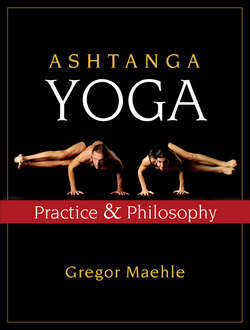Читать книгу Ashtanga Yoga - Gregor Maehle - Страница 25
На сайте Литреса книга снята с продажи.
How to Stretch
ОглавлениеThere are three ways to stretch in a posture: passive, active, and dynamic/ballistic stretching. An example of passive stretching would be folding your torso forward from a standing position and then just hanging from your hip joints with your arms dangling down or your elbows clasped. Passive stretching is relatively ineffective, as it takes a long time to produce results. A person with high muscle tension could hang in a passive stretch for half an hour without getting very far.
This type of stretching has the added disadvantage of not protecting the muscle stretched. For example, if in the posture previously described we reached for the toes and drew the torso down with our arms, the stretch would mainly be taken at the origin of the hamstring muscles, the ischial tuberosities, which are a part of the sit bones. This can result in tearing of muscle fibers, the so-called pulling of the hamstrings. Another downside of passive stretching is that it does not build strength to support the flexibility gained.
The technique employed in Ashtanga Yoga is active stretching. In this type of stretching we use an inherent reflex without which the body could not move. Whenever a muscle contracts, its antagonist (the muscle with the opposite function) releases. To understand this reflex one may look at the elbow joint. When the biceps (biceps brachii) contracts, the triceps (triceps brachii) releases, so that the elbow may be flexed. If the triceps also contracted, the elbow could not move. Likewise, when the triceps contracts, the nervous system simultaneously sends a signal to the biceps to release, and the elbow is extended.
A muscle that is being stretched will receive a signal to release when the opposing muscle is activated. In addition to gravity, it will also be stretched by the strength of the opposing muscle. At the same time, the opposing muscle will be exercised and increase in strength. With this method we will be able to close a joint — flex it — to about 85 percent. To access the remaining 15 percent, we will use a technique we call “active release,” which is covered later.
The other form of stretching is dynamic stretching, mainly used in martial arts, rhythmic gymnastics, and calisthenics. Here one uses momentum to stretch. It is not often employed in yoga as it is considered too forceful. There are some exceptions in Vinyasa Yoga, such as Supta Konasana in the Primary Series and Supta Vajrasana in the Intermediate Series. Dropping into a backbend from standing, handstand drop-backs, and Viparita Chakrasana are other examples of dynamic stretching.
Apart from these exceptions, active stretching is used in the whole of the Ashtanga Yoga practice.
